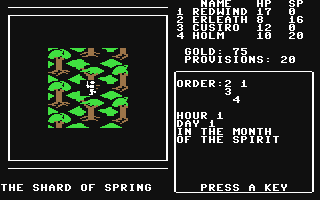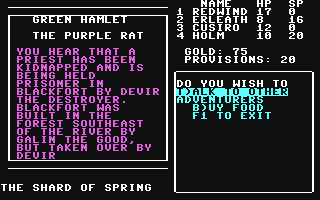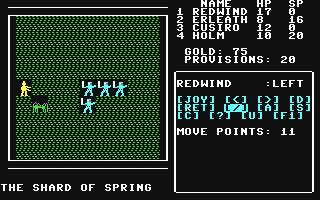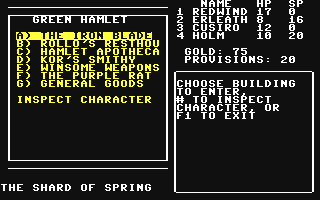|
RATIONALISED
RATINGS
Normal
service is resumed this month, after a brief break last
month to panic over my finals. Finals at Oxford are
conducted in a curious manner, which involves dressing
up in black dinner jackets and bow ties and silting
for 30 hours in a building made of pink marble. It amounted
to psychological disorientation on a grand scale, and
left me little time to go to war. What did I get? I
don't know yet . . . probably a second like everyone
else.
I
thought I'd devote this month's introduction to explaining
my ratings system in detail.
PRESENTATION
Presentation involves everything that doesn't directly
relate to the game, excluding the graphics (which, even
in a strategy game, can be said to be part of the gameplay).
So that doesn't just mean the packaging (though packaging
is important when you've paid for a product), it means
the general on-screen appearance, whether the program
looks 'tatty round the edges', and -- importantly --
what impression the 'front end' makes. In a strategy
game there often has to be a complex orders system,
and this can be very badly designed when programmers
really make an effort.
GRAPHICS
This is self-explanatory, but I try to consider the
distinction between prettiness and usefulness. Good
graphics are those which are appropriate to the game,
and so a few simple, elegantly designed lines can be
better than a screenful of messy colour if the game's
idea is better expressed that way.
RULES
Rules are vitally important to a strategy game, which
so often has to exist in the imagination. I prefer to
see the game mechanics explained (though others don't
like this) and therefore I always commend background
detail.
AUTHENTICITY
This is a nebulous quality. To what extent can a stylised
set of boxes and lines on a television screen ever be
said to be authentic -- especially when what they're
trying to represent is a noisy, smoking, muddy battlefield
in the Napoleonic Wars? Authenticity is the factor by
which a game, through its various aspects, manages to
reduce the gap between reality and what's on screen.
PLAYABILITY
Playability may be generated differently by arcade games
and strategy games, but the effect on the player is
much the same. Playability can probably he boiled down
to 'the promise of more', and it's faintly analogous
to an absorbing plot in a television drama. Empty and
unsatisfactory games can have a high degree of initial
playability -- who, once started, can resist watching
'Neighbours'?
OVERALL
I feel I can give a game a high overall percentage without
much reference to the individual ratings. A game may
be badly presented, have weedy and obstructive graphics,
rules which hardly cover the back of the inlay, and
try to claim that Napoleon invaded India . . . and still
remain fascinating. Most of the individual ratings are
descriptive, but the last three are evaluative.
Having
said all that, I wouldn't take ratings very seriously.
Most of what I really have to say about the game is
contained within the body of the review, and the best
way of judging whether or not you would like to buy
it is to study that and decide if it sounds like the
sort of game you'd enjoy.
.
|
|
Shard
of Spring is a game of a type I would usually pour
scorn upon, the computer 'fantasy roleplaying game'.
As a real live roleplayer, I'm deeply convinced that
it is not possible to reproduce the experience of this
sort of game on a computer. And although Shard of
Spring is a very playable piece of entertainment
software, it's good for reasons other than those which
it intends.
The
action takes place on the island of Ymros, where until
recently, it was always Spring. This phenomenon wag
brought about by the presence on the island of the Shard
of the title, and, due apparently to appalling careless
security precautions, this desirable piece of crystalware
has been stolen by an evil witch called Siriadne. The
temptress has threatened to destroy the crystal and
thus turn Ymros into an icy wasteland unless the peasants
pay tributes to her. The field is clearly wide open
for adventurers to do then stuff.

What
we really have here is an excuse to string together
a collection of dungeons, quests and wilderness encounters
(to use the roleplaying technical terms), based around
a structure of character advancement and acquisition
of wealth. The possibility of eventually winning by
achieving the ultimate objective is also held out. Most
of the game is spent in melee, so it's fortunate that
the close combat system is extremely good.
The
first thing to do is to 'roll up' a party. A party must
consist of at least two, and can contain as many as
five characters. There is no advantage at all in having
fewer than five in your party, as they all add to the
firepower and don't cost much to feed. A human character
can either be a Warner or a Wizard, and the other races
have already had the choice made for them.

Characters
are allocated statistics in the usual range of 'attributes'
by random computer dice-rolls. Although it seems absurd
to give a computer character a statistic for its intelligence,
the 'intellect' attribute makes itself useful by governing
how many skill points can be spent on skills like the
ability to use a sword or to hunt. Similarly, the 'skill'
attribute itself determines the percentage chance of
hitting a target, and strength adds a damage modifier.
When the game lunges into melee combat, the use of all
the attributes is brought immediately to the surface
of the gameplay. They have no feeling of irrelevance,
as happens so often in this type of game.
Warrior
characters can choose from a list of skills specific
to them. They need to have a weapon skill of some sort,
but more unusual skills include armoured skin and persuasiveness,
which lets the character negotiate a discount on items
sold in shops. Wizard skills are slightly different,
because choosing one of the five 'rune' skills allows
the wizard to have at his command a range of six or
seven spells. Finally, and essentially, the character
is named. The latter half of this name has a tendency
to be swallowed by the program when it feels like it,
which gives an amateurish impression.

All
characters are stored on a separate disk (one of yours,
which the program formats for you), and once you've
created as many as you want you can arrange them into
parties. There's space on the disk for 25 characters
and five parties, but you can only go out adventuring
with one party at a time.
Having
swapped disks round once more and entered the game,
the player finds his party represented by a single figure
in the middle of a map. The map is pretty enormous,
and I can vouch for that because I've been mapping it.
What you see on the screen at any one time is a portion
nine by nine square of the landscape surrounding your
party. The basic terrain types are plain, forest, mountains
and marsh, bounded by water. Special locations, such
as towns and the entrances to underground complexes,
are easily identifiable. As might be expected, it takes
longer to cross a mountain square than a plain square,
but the game is not set in 'real time'. The hour of
the day and the day of the month can be called up at
any time. After a certain number of hours it begins
to get dark, and at this point it's a good idea to set
up camp and sleep.

You
can set up camp at any time of the day, and it's often
essential because it's the only way to access a wider
range of options. Once encamped the player can examine
individual members of the party, try to identify potions
and items found, swap round equipment and heal each
other's wounds. The inadvisability of taking too literal
a view of the game is illustrated in this procedure.
If a character buys a weapon and a set of armour in
a town, before he can put on the armour and get the
weapon ready to hand he has to leave the town, go a
little way out into the country, and pitch a tent!
Combat
is extremely well-managed -- and this is a good thing,
for if it weren't one of the beet aspects of the game,
the whole program would be a disaster. When the party
stumbles across something to wave its swords at -- and
you don't see them coming -- the screen display changes
to a blow-up of the area, with characters shown for
the first time as individual figures. Combat always
starts with the opposing sides a few squares apart.
This is where movement points become the currency of
combat; it costs two movement points to move one square,
one to turn around and three to make an attack. Each
character, friend or foe, takes his turn according to
speed. A character's accuracy and ability to inflict
damage depends on his skill rating, his strength, the
type of weapon he's using and the opponent's armour.

The
landscape is interspersed with dungeons and towns. At
the towns you can buy weapons, armour and foods, take
your characters up levels and meet that familiar roleplaying
figure . . . the old man in the pub who tells you what
your next quest will be. The dungeons take you into
the usual subterranean corridors populated with monsters
and hiding treasure.
|